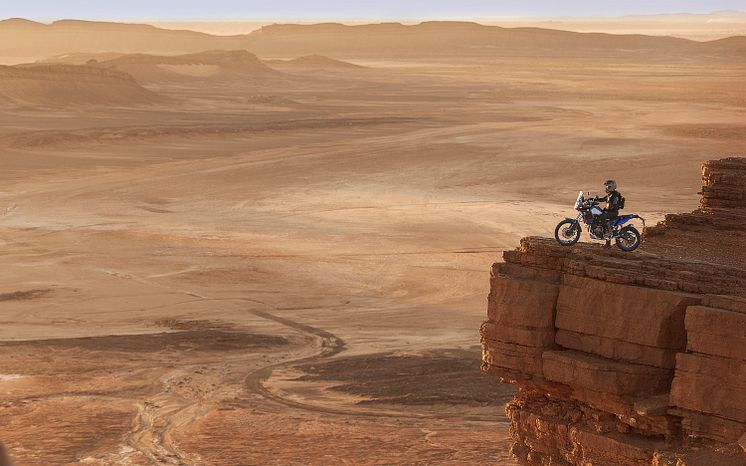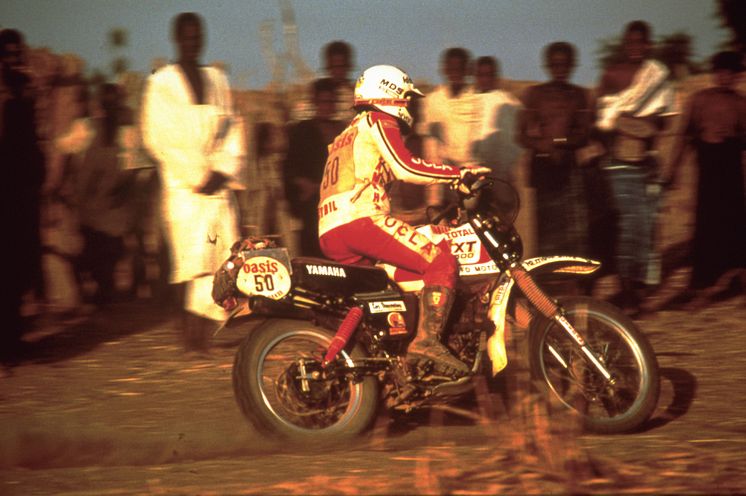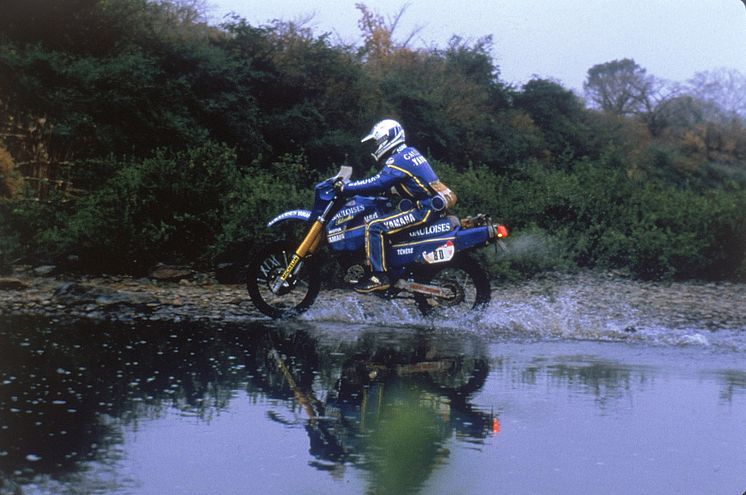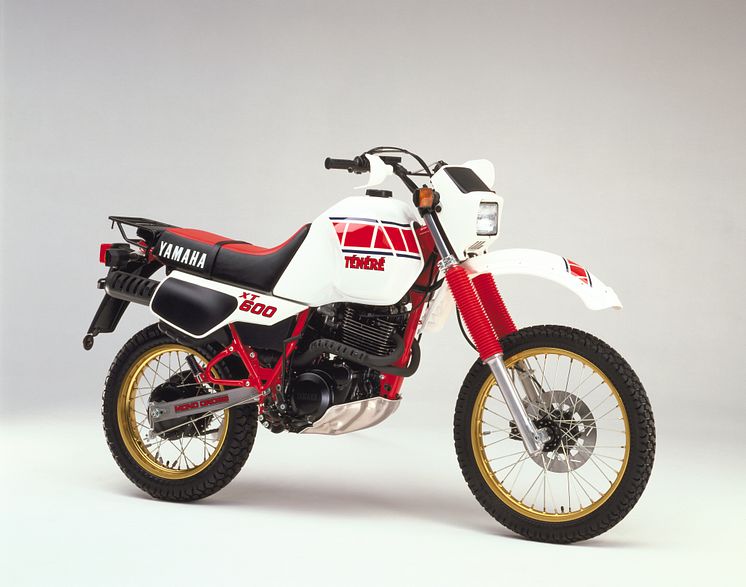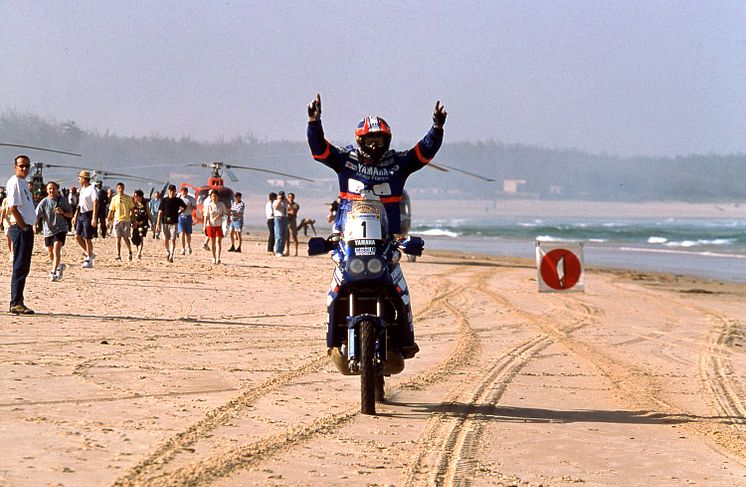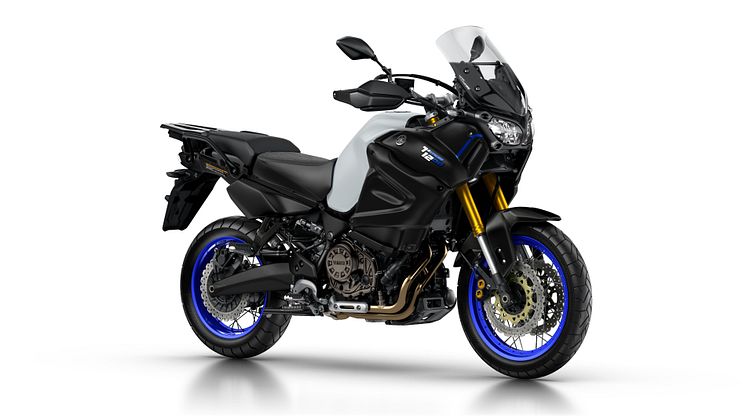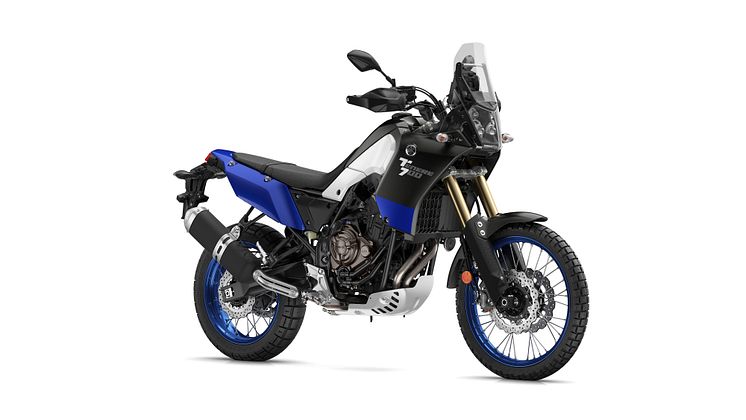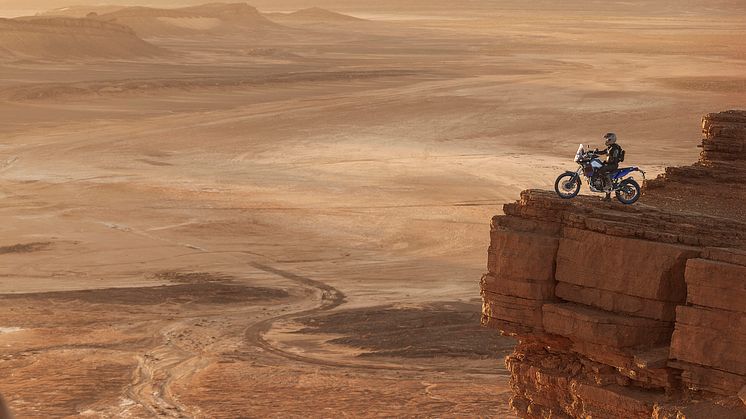
News -
The Real Adventure – Chasing Dreams Beyond the Horizon Yamaha Motor Newsletter (April 30, 2020 No. 80)
Debuting at EICMA in 2018 and already a 2020 winner of international design awards like the iF Design Award and Red Dot Award, the all-new Ténéré 700 is the latest addition to a long line of motorcycles that carry on Yamaha’s Spirit of Adventure, a value born and bolstered in the grueling Paris–Dakar Rally.
The development theme for the model had the project team return to those very roots, seeking to create an authentic go-anywhere machine to take you to the farthest horizon and beyond. Combining a powerful and easy-to-use engine with a rugged but lightweight chassis and tough suspension front and rear, the Ténéré 700 offers not just excellent off-road performance but also practical features for long-distance touring.
Although today’s Dakar Rally is now held far from the sands of the Sahara, the Ténéré brand has remained the partner of riders chasing their dreams of adventure in far-off lands for nearly four decades. In this issue, we delve into the roots of the Yamaha Ténéré brand and its traditions.
Questing for a Fabled Tree in the Heart of the Desert

At the 2nd Paris–Dakar Rally in 1980, Cyril Neveu rode a Yamaha XT500 like future Yamaha Motor France president Jean-Claude Olivier and took a second consecutive victory.
In the Tuareg languages of the nomads in northwest Africa, “Ténéré” means “desert” or “solitude,” and refers to the unforgiving environment of the southern Sahara Desert. The vast, desolate landscape shaped by the winds and sand is what makes the Sahara the natural wonder it is, but within this barren land stood a lone acacia tree that served as a landmark for caravans plying the sea of sand with their cargoes of salt.
Sadly, that tree was lost in 1973 and a metal monument left in its place, but for young adventurers at the time, whether it actually existed or not may have been irrelevant. The dream of searching for the fabled tree in the Ténéré is said to have long been the lure of traveling to the lesser known regions of the African continent.
One modern embodiment of that dream was the Paris–Dakar Rally that began in 1979. Calling on those interested in the journey, the Rally’s organizer Thierry Sabine declared, “I can lead you to the doors of adventure, but it is up to you to open them.” His friend and future president of Yamaha Motor France, Jean-Claude Olivier, was working at Yamaha Motor’s French distributor Sonauto at the time and answered that call by forming a team of himself and three other riders, entering the inaugural Paris–Dakar Rally on four Yamaha XT500 motorcycles.
First released in 1976, the XT500 had been developed alongside the TT500 model designed specifically for competing in the enduro races popular on the west coast of the United States, and mounted a 500cc single-cylinder 4-stroke engine in a semi-double cradle frame. The XT500 was a lightweight, tough and torquey dual-purpose model built to cross the land with raw power.
As a testament to its performance, a lot of other riders besides the Sonauto Yamaha Team chose to enter the Paris–Dakar Rally on the XT500, including the winner of the first and second editions—Cyril Neveu. In fact, the top four places in the motorcycle category at the second Rally went to the XT500, with 11 of the 25 finishers also on the Yamaha, thus demonstrating to the world its performance and reliability across the treacherous 10,000 km course.
The Adventure of Riding on a Different Planet

In the 1985 Paris–Dakar Rally, Olivier rode the bigger 660cc XT600 Ténéré to an impressive 2nd place finish.

The first XT600 Ténéré was released in 1983 and its features included a large 30-liter fuel tank.
In 1980, the Paris–Dakar Rally was officially sanctioned as an international race by both the FIA and FIM and participation soared to 200 and later 300 vehicles. That prompted Yamaha to update the XT500 for riders who dreamed of entering the Rally or just making a desert journey of their own, and released the XT550. And then in 1983, Yamaha launched the first model to bear the Ténéré name, the XT600 Ténéré. It featured a massive 30-liter fuel tank, the first front disc brake ever on a Yamaha off-road model, a bell-crank Monocross suspension, an aluminum swingarm and more. The XT600 went on to become a long-time bestseller, with more than 61,000 units sold in Europe alone over the decade that followed.
The fame of the Rally itself also grew to the point that car, truck and motorcycle manufacturers began entering with factory teams one after another, inevitably raising the speeds run in the race. At Sonauto’s request, Yamaha Motor in Japan became involved with development of a dedicated racebike to keep pace, and this commitment gradually grew deeper with each event. However, although teams racing Yamaha machines were always near the leaders, they were unable to grasp the glory of a third win. In an attempt to remedy the situation, Olivier built the FZ750 Ténéré by basing its engine on the in-line 4-cylinder unit from the FZ750 road bike and entered the 1986 Paris–Dakar Rally on it. Despite struggling with the sheer weight of the machine, he still managed to finish in 12th position. But more importantly, Olivier had sent Yamaha headquarters a strong message of his unwavering determination to win the Rally.
It became the impetus for Yamaha to transfer development of Paris–Dakar machines from the production model divisions to the racing department. The result was the YZE750 Ténéré factory machine that brought together the best of Yamaha’s single-cylinder engine technology. With this machine, Yamaha finished 2nd in 1988 and ’89, and in the meantime, Olivier had looked for new racing talent to lead the next generation and signed to the factory team 22-year-old French enduro champion Stéphane Peterhansel. Yamaha also evolved the Ténéré platform from its single-cylinder origins by developing the 2-cylinder XTZ750 Super Ténéré production model.
All these efforts paid off in 1991 when Peterhansel—in his fourth year competing— rode the 2-cylinder YZE750T Super Ténéré factory machine—in just its second year of development—to a long-awaited victory, showing overwhelming speed and resilience. In the seven years following that win, the Yamaha Ténéré took six more consecutive victories (excluding 1994 when Yamaha did not compete as a factory) and all but one achieved with Peterhansel before Yamaha’s great adventure in the Rally came to an end.
Jean-Claude Olivier, the man that led Yamaha’s teams through the years and competed nine times himself (finishing six times including a 2nd place podium), would later say this about the passion that drove him:
“The Paris–Dakar Rally gave me great pleasure and excitement, because when you’re alone on your bike in the desert, with your mind inside your helmet, you sometimes smile, sing or whistle but you also cry inside your helmet. Because while you smile with joy from how great it feels, at the same time you suffer physically and are emotionally exhausted. I wanted to ride a bike in the desert because it was like piloting a space shuttle or like riding a bike on another planet. The desert was my other planet and that gave me great joy.”
Peterhansel’s Legacy — The 270° Crankshaft
In Peterhansel’s own words: “[The Paris–Dakar] was my dream. It was not my dream to win this race; it was just a dream to do it! And the Yamaha Ténéré at the beginning was a 600cc single-cylinder engine and a few years after, it got bigger with 660cc and 750cc, and Yamaha decided to do a Super Ténéré with a 2-cylinder. So step by step. It was really step by step. Bigger and bigger, faster and faster. And when I started to win my six victories at the Dakar, it was with the Super Ténéré. But ‘Ténéré’ means ‘adventure’ for me.”
Speaking candidly, Yamaha’s last two wins were technically not with a Ténéré or Super Ténéré but with the XTZ850TRX, a competition-only machine that used a key technology that lives on in today’s XT1200Z Super Ténéré and Ténéré 700—a 270° crankshaft. This smoothed out the torque curve and gave the engine more linear power characteristics.
Although it was originally developed to deliver better traction in desert sands, this crankshaft design was first used on the 2-cylinder TRX850 road-going sport bike released in 1995, and then reintegrated into Yamaha’s Paris–Dakar machines from 1996.

The 1998 Paris–Dakar Rally would be the last for Yamaha in the 20th century and Peterhansel gave Yamaha its 9th victory riding the XTZ850TRX featuring a 270° crankshaft.
This unusual development process could be called a legacy of Peterhansel as he rode with the crankshaft to two more victories in 1997 and ‘98. In such ways, Yamaha has fed back a variety of knowledge and technology acquired through the Rally to its production models for nearly 40 years. This is what gives the XT1200Z Super Ténéré and the new Ténéré 700 their rightful pedigree to carry the legendary Ténéré name.
Video: Grand Touring to Morocco on a Yamaha Ténéré 700
A travel log of a 2,200 km journey on the new Ténéré 700 through Europe and down to Morocco by famed Japanese photographer Rowland Kirishima and automotive/motorcycle journalist Keisuke Kawanishi
|
Message from the Editor Last year, I got the chance to accompany Rowland Kirishima and Keisuke Kawanishi and ride for six days through Europe and Africa on the new Ténéré 700. When the ride was finished, Kirishima said something that really struck a chord with me: “If it’s on the Ténéré 700, you really can go anywhere in the world.” He’s right, because a motorcycle with the Ténéré name beckons its rider to head out on a two-wheeled adventure.
Naoto Horie |


